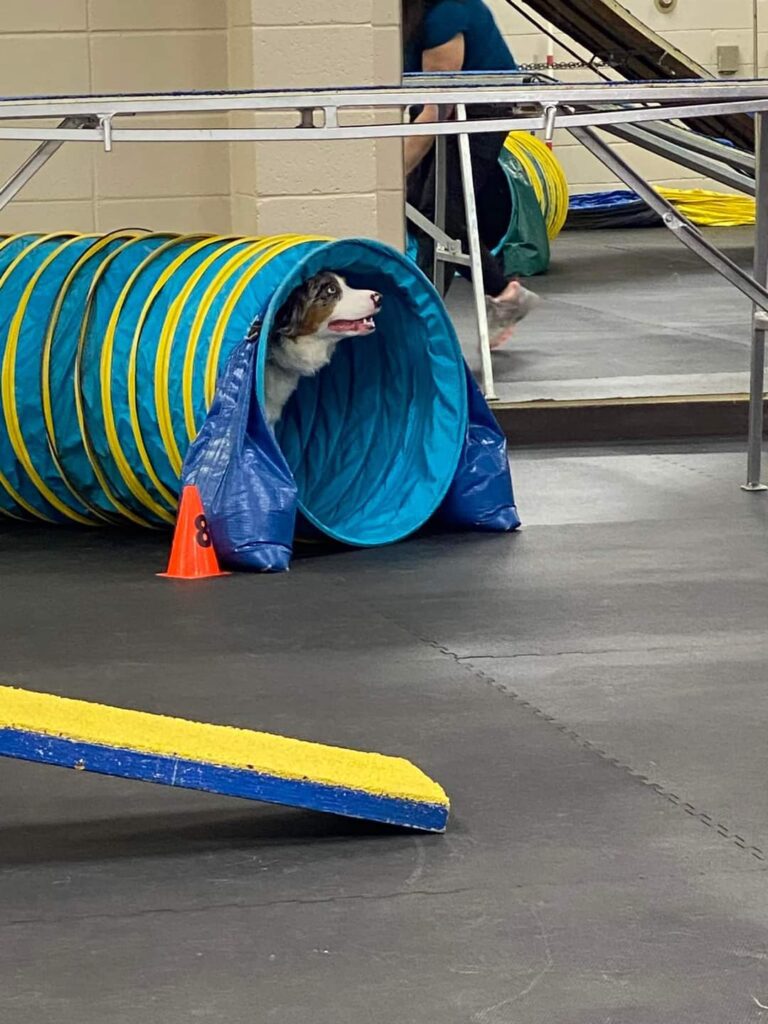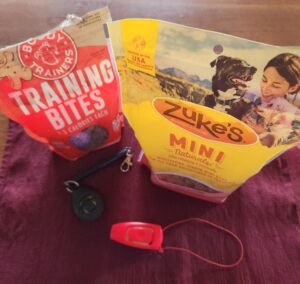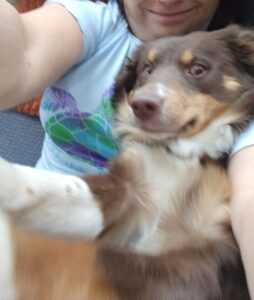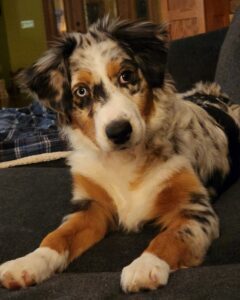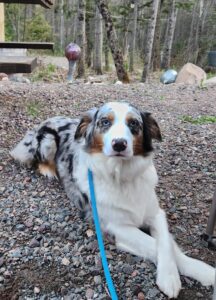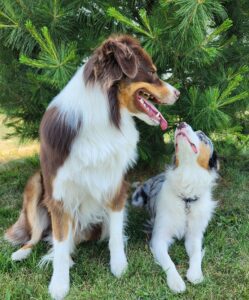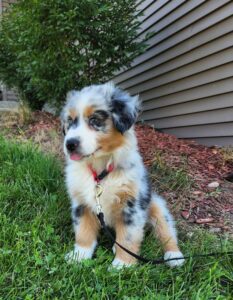Eight to Twelve (8 – 12) Weeks
|
|
| Sustained & Continuous Walking |
- 50 – 200 feet at a time.
- Break up with sniffing and noodling around.
- Formal heeling/leash walking training limited to 2 minutes.
|
| Sniff ‘N Stroll |
- Informal “sniff and stroll” sessions can be up to about 10-15 minutes.
|
| Noodling and Kibble Trails |
- Puppy can go out in a safe yard and explore at his own pace or do a “kibble trail” as long as he likes.
|
| Running |
- No directed running except for very short spurts in play.
- Puppy can run as much as he likes on his own.
|
| Jumping & Impact Activities |
- Bars on the ground to halfway to wrist height.
- No more than one or two obstacles in a row.
- Wobble boards and unstable surfaces, but very low.
- Carpet all indoor stairs and never allow puppy to go up and down stairs unsupervised.
- Put up gates at top/bottom of stairs.
- Carry puppy if he needs to do more than one or two stair steps.
|
| Swimming |
- Puppy should ALWAYS wear a life jacket.
- Wading and playing on the shoreline.
- Climbing on and off low platforms and rafts in shallow water.
- Retrieves/tossing toys in shallow water parallel to shoreline, never into deep water.
- Puppies should be allowed to swim if they volunteer to do so, but never forced.
|
| Chasing |
- Roll balls and drag toys on the ground in gentle circles.
|
| Tugging |
- Keep the toy low so the puppy’s neck is in a straight line.
- Don’t pull on the toy – allow the puppy to tug against you.
|
| Fast Turns |
- No FAST turns or sudden stops.
- No fast weaves or lure coursing.
- They can begin SLOW shaping of weave poles but discontinue if the puppy shows any signs of speeding up or really “weaving” through the poles.
|
|
Free Play With Other Dogs
|
- 10 – 15 minutes for formal “play dates.”
- Puppy can have free access to other puppies and adults in the household (so long as the puppy is not harassing the adults).
- Keep bags of small dog treats on hand and throw handfuls of food down to interrupt rough or overly fast play.
- You may have to enforce rest periods by putting puppy away for naps.
|
Twelve to Sixteen (12 – 16) Weeks
|
|
|
Sustained & Continuous Walking
|
- Gradually increase duration and length of walks, between 100-200 feet by the time the puppy is 16 weeks old.
- Let the puppy volunteer to keep going and stop if he shows reluctance to go further.
- Keep formal training under 2 minutes per session.
|
| Sniff ‘N Stroll |
- Can be increased to 15 – 20 minutes.
|
| Noodling and Kibble Trails |
- Puppy can go out in a safe yard and explore at his own pace or do a “kibble trail” as long as he likes.
|
| Running |
- No directed running except for very short spurts of play.
- Puppy can run as much as he likes on his own.
|
| Jumping & Impact Activities |
- Bars on the ground to halfway to wrist height.
- No more than one or two obstacles in a row.
- Wobble boards and unstable surfaces, but very low.
- Carpet all indoor stairs. Don’t let puppy go up or down stairs unsupervised.
- Put up gates at top/bottom of stairs.
- Consider carrying puppy if he needs to do more than one or two stair steps.
|
| Swimming |
- Puppy should ALWAYS wear a life jacket.
- Wading and playing on the shoreline.
- Climbing on and off low platforms and rafts in shallow water.
- Retrieves/tossing toys in shallow water parallel to shoreline, never into deep water.
- Puppies should be allowed to swim if they volunteer to do so, but never forced.
|
| Chasing |
- Roll balls and drag toys on the ground in gentle circles.
|
| Tugging |
- Keep the toy low so the puppy’s neck is in a straight line.
- Don’t pull on the toy – allow the puppy to tug against you.
|
| Fast Turns |
- No FAST turns or sudden stops.
- No fast weaves or lure coursing.
- Begin SLOW shaping of weave poles but discontinue if the puppy shows any signs of speeding up or really “weaving” through the poles.
|
| Free Play With Other Dogs |
- 10 – 15 minutes for formal “play dates.”
- Puppy can have free access to other puppies and adults in the household (so long as the puppy is not harassing the adults).
- Keep bags of small dog treats on hand and throw handfuls of food down to interrupt rough or overly fast play.
- You may have to enforce rest periods by putting puppy away for naps.
|
Four to Six (4 – 6) Months
|
|
| Sustained & Continuous Walking |
- Gradually increase duration and length of walks. Probably going to be between 200-400 feet at a time by the time the puppy is 6 months old.
- Let the puppy volunteer to keep going and stop if he shows reluctance to go further.
- Keep formal training under 2 minutes per session.
|
| Sniff ‘N Stroll |
- Can be increased to as much as 45 minutes by the time the puppy is 6 months old, provided you are moving at a very slow pace with lots of opportunity for the puppy to stop and noodle around.
|
| Noodling and Kibble Trails |
- Puppy can go out in a safe yard and explore at his own pace or do a “kibble trail” as long as he likes.
|
| Running |
- No directed running except for very short spurts in play.
- Puppy can run as much as he likes on his own.
|
| Jumping & Impact Activities |
- Bars on the ground to halfway to wrist height.
- No more than one or two obstacles in a row.
- Wobble boards and unstable surfaces, but very low.
- Carpet all indoor stairs and never allow puppy to go up and down stairs unsupervised.
- Put up gates at top/bottom of steps.
- Consider carrying puppy if he needs to do more than one or two steps.
|
| Swimming |
- Puppy should ALWAYS wear a life jacket.
- Wading and playing on the shoreline.
- Climbing on and off low platforms and rafts in shallow water.
- Retrieves/tossing toys in shallow water parallel to shoreline, never into deep water.
- Puppies should be allowed to swim if they volunteer to do so, but never forced.
|
| Chasing |
- Roll balls and drag toys on the ground in gentle circles.
|
| Tugging |
- Keep the toy low so the puppy’s neck is in a straight line.
- Don’t pull on the tug – allow the puppy to tug against you.
|
| Fast Turns |
- No FAST turns or sudden stops.
- No fast weaves or lure coursing.
- Do begin SLOW shaping of weave poles but discontinue if the puppy shows any signs of speeding up or really “weaving” through the poles.
|
| Free Play With Other Dogs |
- Up to 20 minutes for formal “play dates.”
- Puppy can have free access to other puppies and adults in the household (so long as the puppy is not harassing the adults).
- Keep bags of small dog treats on hand and throw handfuls of food down to interrupt rough or overly fast play.
- You may have to enforce rest periods by putting puppy away for naps.
|
Six to Twelve (6 – 12) Months
|
|
| Sustained & Continuous Walking |
- Walks on pavement should be kept short, but duration of walks on dirt or turf can be increased and more “hiking” type activities can be introduced.
- Again, best to keep doing these walks as “sniff and strolls” but you can increase sustained walking to up to 20-30 minutes on a relatively level, soft surface by the time the puppy is a year old IF the puppy volunteers to go that far.
|
| Sniff ‘N Stroll |
- Can be increased to as much as 60 minutes by the time the puppy is 12 months old, provided you are moving at a very slow pace with lots of opportunity for the puppy to stop and noodle around.
|
| Noodling and Kibble Trails |
- Puppy can go out in a safe yard and explore at his own pace or do a “kibble trail” as long as he likes.
|
| Running |
- No directed running except for very short spurts in play.
- Puppy can run as much as he likes on his own.
|
| Jumping & Impact Activities |
- Jumps can be gradually raised half way to elbow height between 6 and 12 months old, with correspondingly more challenging romps, wobble boards, and teeters.
- Platform work for rear end awareness can be introduced at this time very carefully and slowly.
- This is also the time most spiral fractures happen because puppies have the capability to get up on high couches and beds – be vigilant about not letting puppies up on high furniture without close supervision.
- Stairs are always a hazard and should have good traction – carpet indoors, non-skid surface outdoors.
- Although the puppy may start doing stairs with good traction at this time, you should still supervise and don’t let him run down the stairs with other dogs.
|
| Swimming |
- Puppy should ALWAYS wear a life jacket.
- Wading and playing on the shoreline.
- Climbing on and off low platforms and rafts in shallow water.
- Retrieves/tossing toys in shallow water parallel to shoreline, never into deep water.
- Puppies should be allowed to swim if they volunteer to do so. Limit swimming to a few minutes at a time.
- Very short swim out to retrieve in the water.
- Keep the toy close to shore. High toy-drive dogs will swim further after a thrown toy than they can or should.
|
| Chasing |
- Roll balls and drag toys on the ground in gentle circles.
|
| Tugging |
- Keep the toy low so the puppy’s neck is in a straight line.
- Don’t pull on the toy – allow the puppy to tug against you.
|
| Fast Turns |
- No FAST turns or sudden stops.
- No fast weaves or lure coursing.
- Begin SLOW shaping of weave poles but discontinue if the puppy shows any signs of speeding up or really “weaving” through poles.
|
| Free Play With Other Dogs |
- Up to 20 minutes for formal “play dates.”
- Your puppy’s increased body mass can make him more liable to injury if he engages in body slamming play or a lot of fast sprints and turns.
- Keep bags of small dog treats on hand and throw handfuls of food down to interrupt rough or overly fast play.
- Puppy can have free access to other puppies and adults in the household (so long as the puppy is not harassing the adults).
- You may have to enforce rest periods by putting puppy away for naps.
|
Twelve to Eighteen (12 – 18) Months
|
|
| Sustained & Continuous Walking |
- Walks on pavement should be kept short, but duration of walks on dirt or turf can be increased and more “hiking” type activities can be introduced.
- Again, best to keep doing these walks as “sniff and strolls” but you can increase sustained walking to up to 20-30 minutes on a relatively level, soft surface by the time the puppy is a year old IF the puppy volunteers to go that far.
|
| Sniff ‘N Stroll |
- OK to do 60 minutes provided you are moving at a slow pace with lots of opportunity for the puppy to stop and noodle around.
|
| Noodling and Kibble Trails |
- Puppy can go out in a safe yard and explore at his own pace or do a “kibble trail” as long as he likes.
|
| Running |
- No directed running except for very short spurts in play.
- Puppy can run as much as he likes on his own.
|
| Jumping & Impact Activities |
- The height can be changed to elbow height between 12-18 months with correspondingly more challenging ramps, wobble boards, and teeters.
- Platform work for rear end awareness can be continued at this time.
- This is also the time when most spiral fractures happen because the puppies have the ability to get up on high couches and beds – be extra vigilant about not letting puppies up on high furniture without close supervision.
- Stairs are always a hazard and should have good traction – carpet indoors, non-skid surface outdoors.
- Although the puppy may continue doing stairs with good traction at this time, you should still supervise and don’t let him run down the stairs with other dogs.
|
| Swimming |
- Puppy should ALWAYS wear a life jacket.
- Wading and playing on the shoreline.
- Climbing on and off low platforms and rafts in shallow water.
- Retrieves/tossing toys in shallow water parallel to shoreline, never into deep water.
- Puppies should be allowed to swim if the volunteer to do so. Limit swimming to a few minutes at a time.
- Short swim out to retrieve in the water.
- Keep the toy close to shore. High toy-drive dogs will swim further after a thrown toy than they can or should.
|
| Chasing |
- Roll balls and drag toys on the ground in gentle circles.
|
| Tugging |
- Keep the toy low so the puppy’s neck is in a straight line.
- Don’t pull on the toy – allow the puppy to tug against you.
|
| Fast Turns |
- No FAST turns or sudden stops.
- No fast weaves or lure coursing.
- Begin SLOW shaping of weave poles but discontinue if the puppy shows any signs of speeding up or really “weaving” through the poles.
|
| Free Play With Other Dogs |
- Up to 20 minutes for formal “play dates.”
- Your puppy’s increased body mass can make him more liable to injury if he engages in body-slamming play or a lot of fast sprints and turns.
- Keep bags of small dog treats on hand and throw handfuls of food down to interrupt rough or overly fast play.
- Puppy can have free access to other puppies and adults in the household (so long as the puppy is not harassing the adults).
- You may have to enforce rest periods by putting puppy away for naps.
|
Eighteen (18) Months to Two (2) Years
|
|
| Sustained & Continuous Walking |
- Hikes and walks can be gradually increased to as long and as rigorous as you and your dog both like, but remember that a dog’s soft tissue is still maturing through about three years old. Increases should be gradual and you should back off if your dog appears tired or reluctant.
|
| Sniff ‘N Stroll |
- Sniff and strolls can be gradually replaced with more sustained “walks” but remember that sniffing is the primary way dogs relate to the world, so continue to give your dog an opportunity to stop and sniff from time to time.
|
| Noodling and Kibble Trails |
- Your dog can go out in a safe yard and explore at his own pace or do a “kibble trail” as long as he likes.
|
| Running |
- Running and endurance training can gradually be introduced at this time.
|
| Jumping & Impact Activities |
- Gradually raise jumps and contact obstacles to full competition height between 18-24 months old.
- Stairs are always a hazard and should have good traction – carpet indoors, non-skid surface outdoors.
|
| Swimming |
- Competition swimming behaviors can be introduced and dog can swim for as long as he volunteers to.
- Life jackets are ALWAYS a must.
|
| Chasing |
- Gauge your play style by your dog’s common sense. If you throw a ball and your dog tumbles head over heels to get it, don’t throw the ball – roll or lob it.
|
| Tugging |
- You can start to hold the tug toy higher but generally it’s best to let the dog tug on the toy rather than you pulling on it.
|
| Fast Turns |
- Full weave pole training and other activities that involve twisting and turning can be introduced.
|
| Free Play With Other Dogs |
- Always be vigilant when your dogs are playing and intervene by throwing handfuls of food down if there’s a lot of body slamming or the play just gets too crazy.
|

